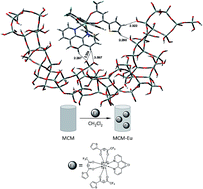Modelling the luminescence of extended solids: an example of a highly luminescent MCM-41 impregnated with a Eu3+ β-diketonate complex†
Abstract
A regular MCM-41 type mesostructured silica was used as a support for the incorporation of the highly luminescent tris(β-diketonate) complex Eu(tta)3ephen yielding the hybrid MCM–Eu material. Suitable characterization by powder X-ray diffraction (XRD), thermogravimetric analyses (TGA), diffuse reflectance infrared Fourier transform spectroscopy (DRIFTS), 13C and 21Si solid state NMR spectroscopy and photoluminescence was accomplished. The combination of ultraviolet-visible spectroscopy (UV-Vis) and photoluminescence techniques shows that the complex incorporation seems to modify essentially the second Eu3+ coordination shell. For a material that has a simply impregnated lanthanide complex, the herein reported maximum 5D0 quantum yield value of 0.31 is a significantly high value, being almost in the same scale of the values obtained for the materials with covalently bonded complexes. A detailed theoretical photoluminescence study of the MCM–Eu with the recently developed Luminescence Package – LUMPAC is presented. The high accuracy of the theoretical calculations is achieved through the comparison with the experimental values. Aiming at a deeper understanding of the photoluminescence process, the ligand-to-Eu3+ intramolecular energy transfer and back-transfer rates were also predicted. The dominant pathway involves the energy transfer between the lowest energy ligand triplet and the 5D0 level (9.70 × 107 s−1).


 Please wait while we load your content...
Please wait while we load your content...